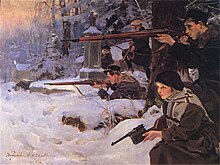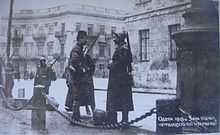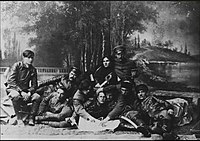Ukrainian War of Independence
This article needs additional citations for verification. (May 2012) |
| Ukrainian War of Independence | ||||||||||
|---|---|---|---|---|---|---|---|---|---|---|
| Part of the Eastern Front of World War I, the Polish–Soviet War, and the Southern Front of the Russian Civil War | ||||||||||
(clockwise from top left): Members of the Yuzovka (Donetsk) First District Executive Committee in 1917; Ukrainian People's Republic soldiers swearing an oath in 1919; Anarchist Black Army command in Berdyansk in 1919; Polish troops in Kyiv in 1920. | ||||||||||
| ||||||||||
| Belligerents | ||||||||||
|
|
|
| ||||||||
| Commanders and leaders | ||||||||||
|
| ||||||||||
| Strength | ||||||||||
|
|
| ||||||||
| History of Ukraine |
|---|
 |
|
|
The Ukrainian War of Independence, also referred to as the Ukrainian–Soviet War in Ukraine, lasted from March 1917 to November 1921. It saw the establishment and development of an independent Ukrainian republic, most of which was absorbed into the Soviet Union as the Ukrainian Soviet Socialist Republic of 1922–1991.
The war was fought between different governmental, political and military forces. Belligerents included
The war ensued soon after the October Revolution, when the Bolshevik leader Vladimir Lenin dispatched the Antonov's expeditionary group to Ukraine and Southern Russia.
The war resulted in the absorption of Ukrainian populations into the newly created Soviet Union and the Second Polish Republic. Soviet historical tradition viewed the Bolshevik victory as the liberation of Ukraine from occupation by the armies of Western and Central Europe, including that of Poland. Modern Ukrainian historians consider it a failed
Background
During the First World War, Ukraine was in the front lines of two of the main combatants,
In response to the
The Central Rada was supported by Ukrainian officers and their men. Those at the
The Central Rada proclaimed four Universals, declaring Ukrainian autonomy on 23 June 1917 (stating that "Ukraine should have the right to order their own lives in their own land”),[4]: 99 [3] issuing recognition agreements between the Central Rada and the Provisional Government in Petrograd on 16 July, and announcing the creation of the Ukrainian People's Republic (UPR) was created on 20 November.[4]
Outbreak of fighting (late 1917 – January 1918)
The Central Rada's authority didn't extend beyond the urban centres,[3]: 99 and following the proclamations, it was faced with external attacks and an internal workers' uprising. The Central Rada lacked a disciplined standing army or state apparatus, and it had to appeal to the population to mobilise.[2]: 207, 209–210 In late December 1917 the Communist Party of Ukraine set up the rival Donetsk–Krivoy Rog Soviet Republic—initially also called the Ukrainian People's Republic—in the eastern city of Kharkiv, where Vladimir Antonov-Ovseenko had established his headquarters. Their intention was initially to cut off Alexey Kaledin's forces in the Don region from Ukraine. In January, the Bolsheviks moved through Ukraine, with the aim of taking Kyiv, and the Central Rada began to lose control of the urban centres as the workers' support for the Bolsheviks increased.[5]: 373–377 [2]: 207–208 The Odessa Soviet Republic, which was created on 18 January, was one of a number of temporary bodies formed by the Bolsheviks.[6]: 76–77
Bolshevik forces led by
Most of the remaining
German intervention

Following Bolshevik negotiations with the
On 12 January the Central Powers, recognized the UPR delegation. Independence of the UPR was proclaimed in the Fourth Universal on 25 January 1918. On 1 February the plenary session was attended by the Kharkiv ‘Soviet Ukrainian government.[8] The first Treaty of Brest-Litovsk was signed on 9 February. In return for much needed food supplies and agricultural products, Germany and Austria promised to provide the UPR with military assistance against the Bolsheviks. The Allied Powers reacted against the treaty and suspended relations with the UPR.[2]: 209–210 [note 1][note 2]
Expulsion of Bolshevik forces
The
On 13 March, Ukrainian troops and the Austro-Hungarian Army secured Odesa.[9] The Ukrainian People's Army took control of the Donets Basin,[10] and Crimea was cleared of Bolshevik forces in April 1918.[9][11] Crimea, although occiped by the Germans, was not annexed by the UPR.[2]: 210–211 Despite these victories, civil disturbances continued throughout Ukraine, where local communists, peasant self-defence groups, and insurgents refused to submit to the Germans.[12]: 364
Hetmanate (April – November 1918)
On 28 April, the Central Rada was disbanded by the Germans,
After the defeat of Germany on the Western Front in November 1918, most of the German troops stationed Ukraine had no wish to remain there in support of the Hetmanate, Skoropadskyi, in an effort to appease the Allies, signed the Federal Charter, which stipulated that Ukraine would be part of a future federal Russia.[14] An anti-Hetman Uprising on 14 November, led by the Ukrainian Social Democratic Labour Party, rose up against Skoropadsky,[2]: 212 followed by an uprising on 16 November 1918 by the Directorate.[15][16]
Skoropadskyi declared martial law, and mobilised his troops to quell the rebellion.[15] The Directorate army initially succeeded in securing most of Ukraine, but were then decisively defeated by remaining German forces.[17] The Siege Corps of the Sich Riflemen captured Kyiv after a two-week siege.[15] Skoropadskyi chose to abdicate, fleeing to Germany,[3][18]: 101 and his government surrendered to the Directorate the next day.[19] On 14 December, the Directory's troops entered the city, taking over the institutions introduced by the Hetmanate.[2]: 212
West Ukrainian People's Republic

In October 1918 Ukrainians announced the formation of the
Simultaneously, the collapse of the Central Powers affected Galicia, which was populated by Ukrainians and Poles. The Ukrainians proclaimed a
Resumed hostilities, 1919
Almost immediately after the defeat of

The defeat of Germany had also opened the Black Sea to the Allies, and in mid-December 1918 some mixed forces under French command were landed at Odesa and Sevastopol, and months later at Kherson and Mykolaiv (Ukrainian: Mykolaiv). Yet, on 2 April, Louis Franchet d'Espèrey ordered Philippe Henri Joseph d'Anselme to evacuate Odessa within 72 hours. Similarly, on 30 April, the French evacuated Sevastopol. According to Kenez, "The French withdrew not in order to avoid defeat, but in order to avoid fighting. They had no plans for evacuation. The French left behind enormous stores of military material. They embarked on an ambitious scheme without clear goals, without an understanding of the consequences and with insufficient forces."[23]: 180–202
A new, swift Bolshevik offensive overran most of Eastern and central Ukraine in early 1919. Kyiv—under the control of Symon Petliura's Directorate—fell to the Red Army again on 5 February, and the exiled Soviet Ukrainian government was re-instated as the Ukrainian Soviet Socialist Republic. The Ukrainian People's Republic (UPR) was forced to retreat into Eastern Galicia along the Polish border, from Vinnytsia to Kamianets-Podilskyi, and finally to Rivne. According to Chamberlin, April was the greatest Soviet military success in Ukraine, "The Soviet regime was now at least nominally installed all over Ukraina, with the exception of the portion of the Donetz Basin which was held by Denikin." Yet in May, the Soviets had to deal with the mutiny of Otaman Nykyfor Hryhoriv and the advance of Denikin's forces.[24]
On 25 June 1919,
Yet by winter the tide of war reversed decisively, and by 1920 all of Eastern and central Ukraine except Crimea was again in Bolshevik hands. The Bolsheviks also defeated Nestor Makhno.[citation needed]
Polish involvement, 1920
Again facing imminent defeat, the UPR turned to its former adversary, Poland; and in April 1920, Józef Piłsudski and Symon Petliura signed a military agreement in Warsaw to fight the Bolsheviks together. Just like the former alliance with Germany, this move partially sacrificed Ukrainian sovereignty: Petliura recognised the Polish annexation of Galicia and agreed to Ukraine's role in Piłsudski's dream of a Polish-led federation in Central and Eastern Europe.
Immediately after the alliance was signed, Polish forces joined the Ukrainian army in the Kyiv offensive to capture central and southern Ukraine from Bolshevik control. Initially successful, the offensive reached Kyiv on 7 May 1920. However, the Polish-Ukrainian campaign ended in total failiure: in late May, the Red Army led by Mikhail Tukhachevsky staged a large counter-offensive south of Zhytomyr which pushed the Polish army almost completely out of Ukraine, except for Lviv in Galicia. In yet another reversal, in August 1920 the Red Army was defeated near Warsaw and forced to retreat. The White forces, now under General Wrangel, took advantage of the situation and started a new offensive in southern Ukraine. Under the combined circumstances of their military defeat in Poland, the renewed White offensive, and disastrous economic conditions throughout the Russian SFSR—these together forced the Bolsheviks to seek a truce with Poland.
End of hostilities, 1921
Soon after the Battle of Warsaw the Bolsheviks sued for peace with the Poles. The Poles, exhausted and constantly pressured by the Western governments and the League of Nations, and with its army controlling the majority of the disputed territories, were willing to negotiate. The Soviets made two offers: one on 21 September and the other on 28 September. The Polish delegation made a counteroffer on 2 October. On the 5th, the Soviets offered amendments to the Polish offer, which Poland accepted. The Preliminary Treaty of Peace and Armistice Conditions between Poland on one side and Soviet Ukraine and Soviet Russia on the other was signed on 12 October, and the armistice went into effect on 18 October.[25][26] Ratifications were exchanged at Liepāja on 2 November 1920. Long negotiations of the final peace treaty ensued.
Meanwhile, Petliura's Ukrainian forces, which now numbered 23,000 soldiers and controlled territories immediately to the east of Poland, planned an offensive in Ukraine for 11 November but were attacked by the Bolsheviks on 10 November. By 21 November, after several battles, they were driven into Polish-controlled territory.[27]
On 18 March 1921, Poland signed a peace treaty in Riga, Latvia, with Soviet Russia and Soviet Ukraine. This effectively ended Poland's alliance obligations with Petliura's Ukrainian People's Republic. According to this treaty, the Bolsheviks recognized Polish control over Galicia (Ukrainian: Halychyna) and western Volhynia—the western part of Ukraine—while Poland recognized the larger central parts of Ukrainian territory, as well as eastern and southern areas, as part of Soviet Ukraine.
Having secured peace on the Western front, the Bolsheviks immediately moved to crush the remnants of the
and seized a cache of military supplies, but on 17 November 1921, this force was surrounded by Bolshevik cavalry and destroyed.Aftermath
In the current
In 1922, the Russian Civil War was coming to an end in the
The political status of Ukraine remained unchanged until the
Popular culture
The war was portrayed in Mikhail Bulgakov's novel The White Guard,[31] which was serialised in 1925.[32]
Songs such as "Oi u luzi chervona kalyna" ("Oh, the guilder rose in the meadow, bent down") and "Hei vydno selo pid horoyu" ("Look, a village at the foot of the mountain") that were adapted or wriiten for the Ukrainian Sich Riflemen, became widely popular in Ukraine at the time. Because of their patriotic content, they were banned by the Soviets during much of the 20th century.[33]
See also
- Unification Act
- Ukrainian Death Triangle
- First Winter Campaign
- Second Winter Campaign
- Ukrainian Air Force
- Ukrainian People's Republic Air Fleet
- Navy of the Ukrainian People's Republic
Notes
References
- ISBN 978-08020-8-390-6.
- ^ ISBN 978-04650-9-346-5.
- ^ ISBN 0-8133-3792-5.
- ^ a b c d Zhukovsky, Arkadii. "Struggle for Independence (1917–20)". Internet Encyclopaedia of Ukraine. Canadian Institute of Ukrainian Studies. Retrieved 25 September 2023.
- ^ OCLC 313563398.
- ISBN 978-1-894865-40-1.
- ISBN 978-07102-1-298-6.
- ^ a b c d e Borschak, Elie. "Brest-Litovsk, Peace Treaty of". Internet Encyclopaedia of Ukraine. Canadian Institute of Ukrainian Studies. Retrieved 28 September 2023.
- ^ a b c Tynchenko, Yaros (23 March 2018). "The Ukrainian Navy and the Crimean Issue in 1917–18". The Ukrainian Week. Retrieved 14 October 2018.
- ^ Zhukovsky, Arkadii. "Ukrainian-Soviet War, 1917–21". Internet Encyclopaedia of Ukraine. Canadian Institute of Ukrainian Studies. Retrieved 28 September 2023.
- ^ "Germany Takes Control of Crimea". New York Herald. 18 May 1918. Retrieved 29 September 2023.
- ISBN 978-966-00-1145-8.
- Radio Svoboda(in Ukrainian). Retrieved 29 September 2023.
- ^ Hai-Nyzhnyk, Pavlo (2011). "Державний переворот 29 квітня 1918 р.: причини та перебіг захоплення влади П.Скороспадським" [The coup of 29 April 1918: reasons and course of P. Skoropadskyi's seizure of power]. Ukrainian Historic Journal (4): 132–164.
- ^ a b c Boiko, Olena. "Протигетьманське Повстання 1918" [Anti-Hetman Uprising, 1918]. Institute of History of Ukraine (in Ukrainian). Retrieved 15 September 2023.
- ^ "Антигетьманське повстання Директорії: опозиційний рух чи заколот проти держави?" [The Directorate's Anti-Hetman Uprising: Opposition movement or anti-state uprising?]. The Ukrainian Week (in Ukrainian). 16 May 2023. Retrieved 15 September 2023.
- ^ Shurkhalo, Dmytro. "Повстання проти гетьмана Скоропадського: Директорія виграла, але Україна втратила" [Uprising against hetman Skoropadskyi: The Directory won, but Ukraine lost]. Radio Free Europe/Radio Liberty (in Ukrainian). Retrieved 15 September 2023.
- ^ "Pavlo Skoropadskyi – Hetman of the Ukrainian State 1918". British Library. 24 August 2018. Retrieved 15 September 2023.
- ^ Balan, B.; Shulhyn, O.; Zhukovsky, A. "Hetman government". Internet Encyclopaedia of Ukraine. Canadian Institute of Ukrainian Studies. Retrieved 15 September 2023.
- ^ a b Plokhy 2016, p. 212.
- ^ Reid 2000, p. 102.
- ^ Zhukovsky, Arkadii. "Struggle for Independence (1917–20)". Internet Encyclopaedia of Ukraine. Canadian Institute of Ukrainian Studies. Retrieved 25 September 2023.
- ^ ISBN 978-0974493459.
- ^ Chamberlin, William (1935). The Russian Revolution, 1917–1921, Volume Two. New York: The Macmillan Company. pp. 209–219.
- ^ "Wojna polsko-bolszewicka" [Polish-Bolshevik War]. Entry at Internetowa encyklopedia PWN. (in Polish). Retrieved 27 October 2006.
- ^ League of Nations Treaty Series, vol. 4, pp. 8–45
- Volodymyr Kubiyovych, ed. (1963). "Ukraine". A Concise Encyclopedia. Vol. I. Toronto: University of Toronto Press. pp. 831–833, 872–874.
- ^ "На вшануванні отамана освячували ножі" [Knives were consecrated at the commemoration of the chieftain]. Gazeta.ua (in Ukrainian). 21 April 2010. Retrieved 23 October 2022.
- ^ "Gerashchenko offers a National Park "Cold Yar"". Ukrinform (in Ukrainian). 19 October 2016.
- ^ "Russian-Ukrainian war never stopped". Gazeta.ua. 12 December 2014. Archived from the original on 26 June 2023.
- ^ Mikhail Bulgakov: The White Guard. Penguin Books. 7 January 2010. Retrieved 25 September 2023.
- Britannica. Retrieved 25 September 2023.
- ^ Wolynetz, Lubow (25 November 2018). "Songs of Ukrainian World War I Soldiers" (PDF). The Sower. Stamford, Connecticut: The Ukrainian Museum and Library of Stamford. p. 13. Retrieved 26 September 2023.
Further reading
- Courtois, Stéphane (1999). The Black Book of Communism: Crimes, Terror, Repression. ISBN 978-06740-7-608-2.
- Magocsi, Paul R. (2007). Ukraine: An Illustrated History. Seattle: ISBN 978-02959-8-723-1.
- "31 серпня 1919 року. Як галичани з денікінцями Київ звільняли" [August 31, 1919: How Galicians and Denikians liberated Kiev]. Ukrayinska Pravda(in Ukrainian). 31 August 2012. Retrieved 25 September 2023.
External links
- J. Kim Munholland. "The French army and intervention in Southern Russia, 1918–1919". Cahiers du monde russe (in French). Editions Ehess. Archived from the original on 10 June 2007. Retrieved 8 November 2007.
- "The beginning of the Civil War and war intervention". RKKA (in Russian). Retrieved 8 November 2007.
- Der Vormarsch der Flieger Abteilung 27 in der Ukraine (in German) (The advances of Flight Squadron 27 in Ukraine). This portfolio, comprising 263 photographs mounted on 48 pages, is a photo-documentary of the German occupation and their military advances through southern Ukraine in the spring and summer of 1918.




